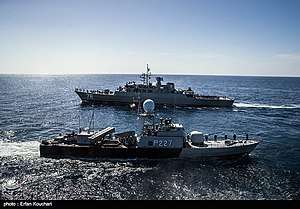IRIS Shamshir (P227)
IRIS Shamshir (Persian: شمشیر, lit. 'Sword') is a Kaman-class fast attack craft in the Southern Fleet of the Islamic Republic of Iran Navy.
 Shamshir (front) with Jamaran (back) | |
| History | |
|---|---|
| Name: | Shamshir |
| Namesake: | Shamshir |
| Operator: | Islamic Republic of Iran Navy |
| Ordered: | 14 October 1974 |
| Builder: | Constructions de Mécaniques, Cherbourg |
| Laid down: | 15 May 1976 |
| Launched: | 12 September 1977 |
| Commissioned: | 31 March 1978 |
| Refit: | 2014 |
| Status: | In service |
| General characteristics (as built) | |
| Class and type: | Kaman-class fast attack craft |
| Displacement: |
|
| Length: | 47 m (154 ft 2 in) |
| Beam: | 7.1 m (23 ft 4 in) |
| Draft: | 1.9 m (6 ft 3 in) |
| Installed power: | 4 × MTU 16V538 TB91 diesels, 14,400 brake horsepower (10.7 MW) |
| Propulsion: | 4 × shafts |
| Speed: | 36 knots (67 km/h) |
| Range: | 2,000 miles (3,200 km) at 15 knots (28 km/h); 700 miles (1,100 km) at 33.7 knots (62.4 km/h) |
| Complement: | 30 |
| Armament: | |
| Notes: | As reported by Jane's (1979)[1] |
Construction and commissioning
Shamshir was built by French Constructions Mécaniques de Normandie at Cherbourg, as one of the second six contracted on 14 October 1974.[2] Her keel was laid down on 15 May 1976 and on 12 September 1977, she was launched.[2] Together with Falakhon and Paykan, she was commissioned into the fleet on 31 March 1978.[2]
Service history
During Iran-Iraq War, her home port was Bushehr Naval Base.[3]
Her refit was completed in c. 2014 and Iranian chief of naval operations was quoted as saying, "Shamshir missile-launcher warship is capable of firing different mid-range and long-range surface-to-surface missiles, including Nour and Qader, or any other type of missile after its recent overhaul... The warship also has a double-purpose surface-to-surface and surface-to-air artillery which has been built by Iranian industries and the defense ministry and was tested successfully in the drills".[4] He also added that she is equipped with domestically-built radars and new weapons systems, including 76mm caliber cannons.[4]
Starting on 9 April 2014, Shamshir departed home for a six-day search and rescue joint drill with Pakistan Navy and Royal Navy of Oman vessels.[5] Other Iranian vessels in this drill were Alvand, Bushehr and Atashbar, the latter of Revolutionary Guard Corps.[5]
References
- Moore, John, ed. (1979). Jane's Fighting Ships 1979–80. London: Jane's Yearbooks. p. 256. ISBN 0-354-00587-1.
- Gardiner, Robert; Chumbley, Stephen; Budzbon, Przemysaw, eds. (1996), "Iran", Conway's All the World's Fighting Ships: 1947–1995, Conway Maritime Press, pp. 183–188, ISBN 978-1557501325
- Razoux, Pierre (2015). The Iran-Iraq War. Harvard University Press. Appendix D, Table D6, p. 528. ISBN 978-0-674-91571-8.
- "Iran's Overhauled Warship Proves Successful in Joint Drills with Oman", Fars News Agency, 9 April 2014, retrieved 5 August 2020
- Nadimi, Farzin (April 2020), "Iran's Evolving Approach to Asymmetric Naval Warfare: Strategy and Capabilities in the Persian Gulf" (PDF), The Washington Institute for Near East Policy (Policy Focus) (164), Appendix E: IRIN’s Long-range Task Forces And Naval Visits Abroad, pp. 64–74, retrieved 15 July 2020